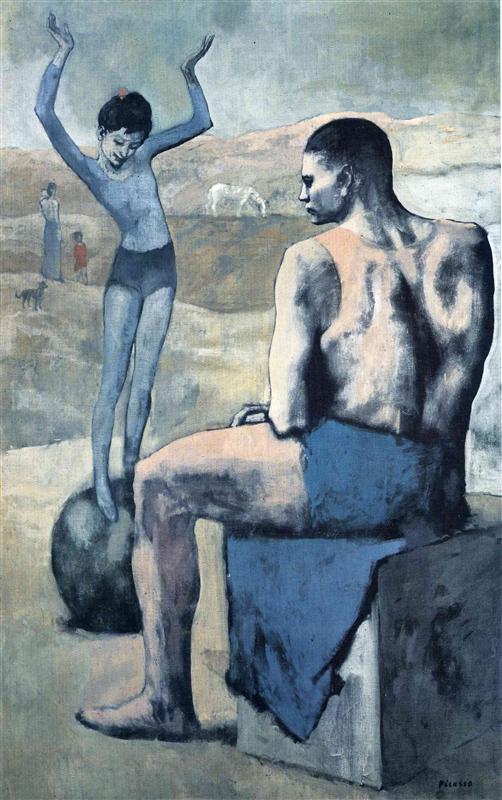The painting “Girl on the Ball” opens the so-called “pink period” of the work of Pablo Picasso. At this time, he finally moved to Paris. He makes new acquaintances, friendship, relationships with Fernanda Olivier.
The paintings acquire a light pink, airy saturation – pearl-gray, pink-red, ocher tones differ significantly from the previous, sad and static “blue period” of the master.
Picasso succumbed to the general fascination with circus plots, which were very popular at the time. His works depict wandering actors and comedians, convey a certain mood, and are distinguished by their vital content.
“Girl on a Ball” is a masterpiece, the main message of which is the opposition of lightness, flexibility and stability, massiveness, a statement of two different forms, dissimilarity, “extremes” of being. This is the grace of an acrobat girl, and the solidity of the athlete, the mobility of the ball and the stability of the cube.
The canvas is built on contrasts, filled with inner drama. The background of the picture is a dull landscape, the earth scorched by the sun, on which a lone horse, a woman with a child, is grazing, walking somewhere, a hilly area, a country road … Constancy that will remain unchanged for a very long time.
The background is contrasted with wandering artists, whose life is always in motion, always in a crowd. The silence of the background ends with the arrival of the circus performers, bringing with them an atmosphere of fun and noisy joy.
The artists’ props – a ball and a cube – are also played up by the artist as opposed to stability, constancy, to movement, variability. Flexibility, the grace of a girl keeping balance, and a frozen athlete who merged with his pedestal.
Delicate pink, pearl tones, novelty and a feeling of fullness, airiness, lightness, are emphasized by a colorful stroke – a bright red flower in the hair of a girl gymnast. This is practically the only bright spot that attracts attention among the pastel-calm colors of the picture.
It is worth noting that the artists of that time, and Picasso in particular, identified themselves with circus actors – social outcasts, whose craft is spectacle that the crowd craves.
In the Medrano circus, which was located at the Montmartre hill, Picasso finds a lot of interesting material for himself – people: adults and very young, beautiful and ugly, who perfectly own their skills. There is also a rich palette of costumes, gestures, characters.
The characters of the master from the “blue period” of creativity cannot boast of such a variety of real volumes, forms, fullness of life – they are more static, motionless. Poverty and sadness in the “pink period” is replaced by a lively, mobile world of circus and theater.
Also, the muse of the master in this period is Fernande Olivier – a model with curvaceous forms, inspiring the artist to create such an image as a woman guitar. They live in Bato Lavour – this strange haven of poets, merchants, artists, janitors on the verge of poverty, but in perfect creative disorder.
The painting “Girl on a Ball” (the so-called “bridge” between the “blue” and “pink” periods in the artist’s work) came to Russia thanks to Ivan Abramovich Morozov, who bought it from Kahnweiler in 1913 for 16 thousand francs. Prior to that, the canvas was in the collection of Gertrude Stein. For comparison, in 1906 Vollard bought 30 paintings from Picasso for 2 thousand francs.
To date, the painting “Girl on the Ball” is in the State Museum of Fine Arts. A.S. Pushkin in Moscow.
Year of painting: 1905.
Dimensions of the painting: 147 × 95 cm.
Material: canvas.
Writing technique: oil.
Genre: genre painting.
Style: expressionism, symbolism.
Gallery: The Pushkin State Museum of Fine Arts, Moscow, Russia.



